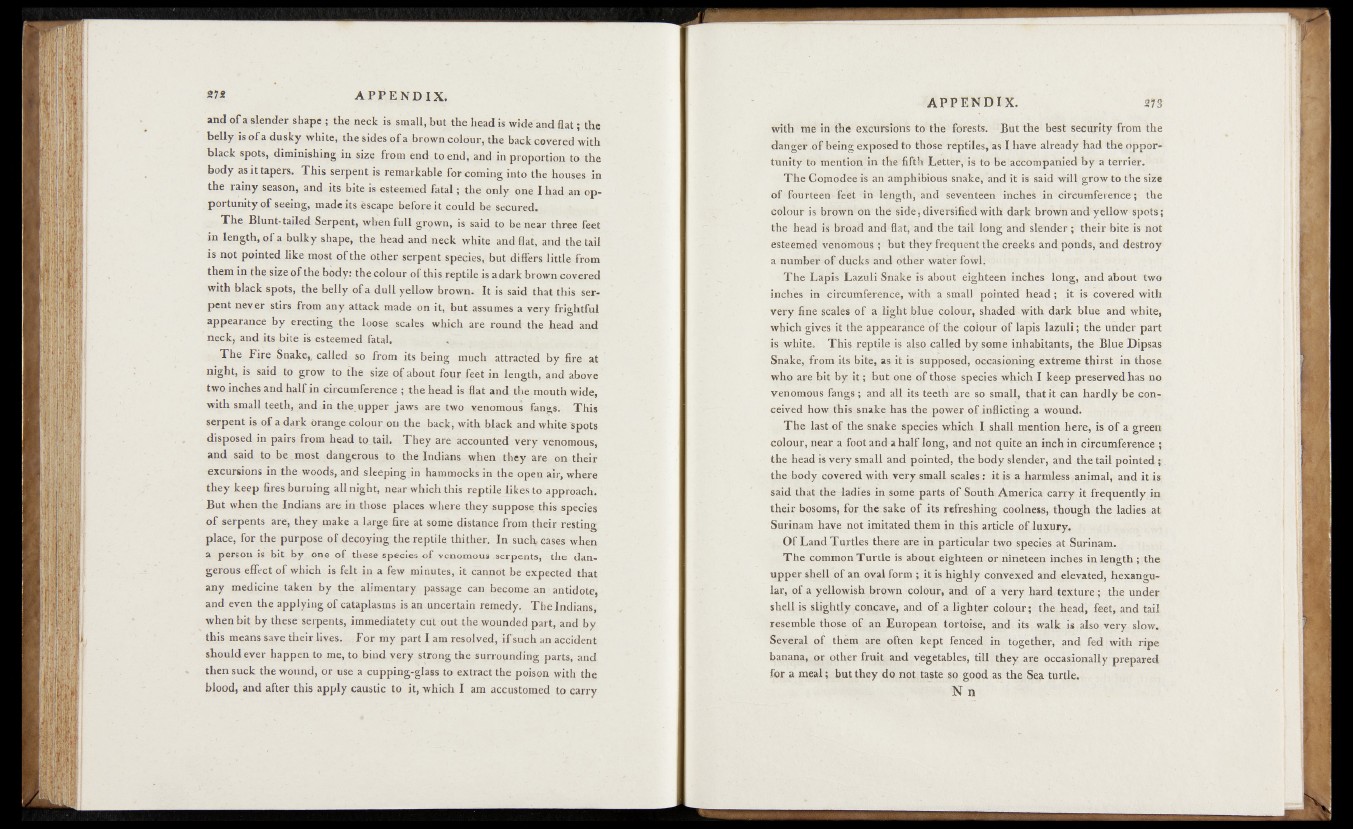
and o f a slender shape ; the neck is small, but the head is wide and flat; the
belly is Of a dusky white, the sides of a brown colour, the back covered with
black spots, diminishing in size from end, to end, and in proportion to the
body as it tapers. This serpent is remarkable for coming into the houses in
the rainy season, and its bite is esteemed fatal; the only one I had an opportunity
of seeing, made its escape before it could be secured.
The Blunt-tailed Serpent, when full grown, is said to be near three feet
in length, of a bulky shape, the head and neck white and flat, and the tail
is not pointed .like most of the other serpent species, fiut differs little from
them in the size of the body: the colour of this reptile is adark brown covered
with black spots, the belly of a dull yellow brown. It is said that .this serpent
never stirs from any attack made on it, but kssumes a very frightful
appearance by erecting the loose scales which are round the head and
neck, and its bite is;esteemed fatal. _
The Fire Snake* called so from its being much attracted by fire at
night, is said to grow to the size of about four feet in length, and above
two inches and half in circumference ; the head is flat and the mouth wide,
with small teeth, and in the upper jaws are two venomous fangs. This
serpent is of a dark orange colour on the back, with black and white spots
disposed in pairs from head to tail. They are accounted very venomous,
and said to be .most dangerous to the Indians when they are. on their
excursions in the woods, and sleeping in hammocks in the open air, where
they keep fires burning all night, nearwhich this reptile likes to approach.
But when the Indians are in those places where they suppose this species
o f serpents are, they make a large fire at some distance from their resting
place, for the purpose of decoying the reptile, thither. In sucfy cases when
a person is bit by one of these species o f venomous serpents, the dangerous
effect o f which is felt in a few minutes, it cannot be expected that
any medicine taken by the alimentary passage can become an antidote,
and even the applying of cataplasms is an. uncertain remedy. The Indians,
when bit by these serpents, immediately cut out the wounded part, and by
this means saye their lives. For my part I am resolved, i f such an accident
should ever happen to me, to bind very strong the surrounding parts, and
then suck the wound, or use a cupping-glass to extract the poison with the
blood, and after this apply caustic to it, which I am accustomed to carry
with me in the èjcchfêtöh®' to'the' förestsi thé bést security from the
dangéi'.of being exposed tö those reptiles, as I have already had the opportunity
to 'mentioh 'in the-fifth I<ettfer,!is to be accompanied by a terrier.
The Gomodeë Is an amphihibtis snake,-and it is said \^ill grow to the size
of fourteen-feet in length,-and'seventeen inches in circumferencethe
colour Is: brown on the side, diversified with dark brown and yellow spots;
the head is broad and flatland the-tail* loög ahd-Slé'nder; thèir bite is not
esteemed1 vënömöOS •;: vu#;tn:fey frö^éfthpié^drëéks and ponds, and destroy
a number of ducks and other water fowl. > *
The Lapis Lazuli Snake is ahbut eighteen inches long, and about two
inches in circumference, with a small pointed' head ; (it is covered with
very fine scales of a light bine colour, shaded with dark blue and white,
which gives it the appearance o f the colour of lapis lazuli; the under part
is white, This reptile is also called by some inhabitants, the Blue Dipsas
Snake, from its bite, as. it is supposed, oqcasioning extreme thirst in those
who are bit by i t ; hut one of those species whicfi I keep preserved has no
venomous fangs ; and all its teeth are so small, that it can hardly be con»
ceived how this,snake has the power of .inflicting a wound.
The last of the snake species which I shall mention .here, is of a green
colour, near a foot and a half long, and not quite an inch in circumference $
the head is very small and pointed, the body slender, and the tail pointed;
the body covered with very small scales r it is a harmless animal, and it is
said that the ladies in some parts of South America carry it frequently in
their bosoms, for the. sake of its refreshing coolness, though the ladies at
Surinam have not imitated them in this article i^ p x p r y , M
Of Land Turtles there are in.particular two species at Surinam.
The common Turtle is about eighteen or nineteeq inches in length ; the
upper shell of an oval form ; it is highly convexed and elevated, hexangu-
lar, of a yellowish brown colour, and of a very hard texture ; the under
shell is .slightly concave, and of a lighter colour ; tlie head, feet, and tail
resemble those of. an European tortoise^ and its walk is.also very slow.
Several of. .thérp are often kept fenced in together, and fed with ripe
banana, or other fruit; and vegetables, till they, are occasionally prepared
for a meal; but they do not taste so. good as the Sea turtle.
| 'N n